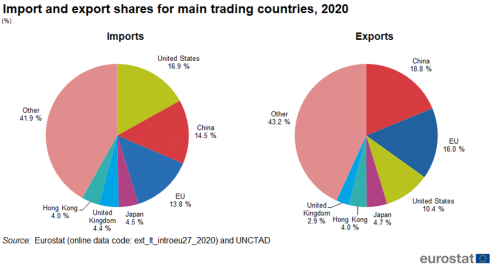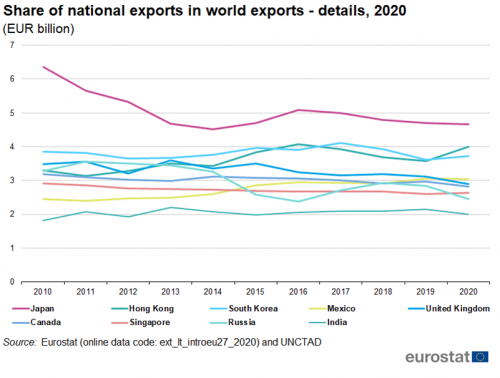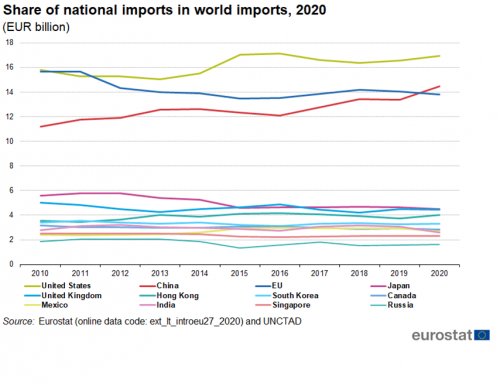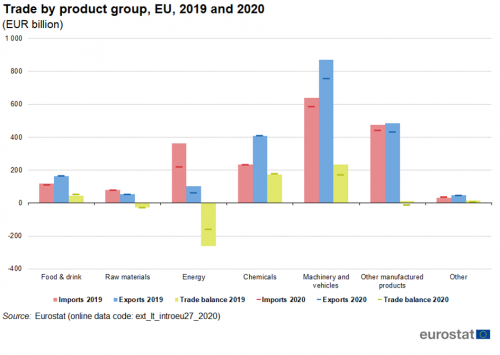Archive:EU and main world traders
Data extracted in October 2020
Planned update: 14 October 2021
Highlights
The EU, the United States and China together accounted for 45 % of both imports and exports goods globally in 2020.
Machinery and vehicles were the most traded goods in 2020 for the EU, the United States and China.

(%)
Source: Eurostat (ext_lt_introeu27_2020) and UNCTAD
International trade — especially the size and evolution of imports and exports — is an important indicator of a country’s economic performance, showing its status on the international stage.
This article takes a closer look at recent trends in the imports and exports of goods by several of the world’s largest economies, focusing on key trade statistics for goods and giving an insight into EU trading patterns compared to the world’s major economies. The article only deals with extra-EU trade, and does not consider trade between EU Member States (intra-EU trade).
This article is part of the online publication International trade in goods - a statistical picture which provides recent statistics on international trade in goods, covering information on the EU's main partners, main products traded, specific characteristics of trade as well as background information.
Full article
Main world traders: EU, USA and China
In 2020, the EU, the United States and China recorded by far the world’s highest trade in goods values. Together, these countries accounted for around 45 % of global imports as well as exports of goods (see Figure 1).</newarticle>

(%)
Source: Eurostat (ext_lt_introeu27_2020) and UNCTAD
In 2020, China recorded the world’s highest export values at EUR 2 268 billion, followed by the EU and the United States, which recorded values of EUR 1 932 billion and EUR 1 252 billion respectively (see Figure 2). Looking at imports by value, the United States had a higher value (EUR 2 106 billion) than China (EUR 1 800 billion) and the EU (EUR 1 715 billion). The United States also recorded the highest trade deficit (EUR 854 billion), followed by the United Kingdom (EUR 203 billion), India (EUR 81 billion), Hong Kong (EUR 19 billion) and Canada (EUR 14 billion). The largest trade surpluses were recorded by China (EUR 468 billion), followed by the EU (EUR 218 billion), Russia (EUR 91 billion), South Korea (EUR 40 billion), Mexico (EUR 30 billion), Singapore (EUR 29 billion) and Japan (EUR 5 billion).

(EUR billion)
Source: Eurostat (ext_lt_introeu27_2020) and UNCTAD
The United States has traditionally been a major exporting economy, but its significance was already smaller than that of the EU and China in 2010 (see Figure 3a). The United States' share in total exports increased slightly from 10.6 % to 11.5 % in 2016 and but decreased back to 10.4 % in 2020. The steady growth of China’s exports saw it overtaking the EU in 2015, reaching a peak of 18.8 % in 2020. The EU had a share of 15.7 % in 2010 which did not change much over time, reaching 16.0 % in 2020. The national export shares of the other main traders are shown separately in Figure 3b to give some more detail.

(EUR billion)
Source: Eurostat (ext_lt_introeu27_2020) and UNCTAD

(EUR billion)
Source: Eurostat (ext_lt_introeu27_2020)
China’s share in world imports has also increased, from 11.2 % in 2010 to 14.5 % in 2020, overtaking the EU (see Figure 4a). The United States remains the largest importer of goods, its share rose from 15.8 % in 2010 to 16.9 % in 2020. The EU saw a large reduction from 15.6 % in 2010 to 13.8 % in 2020. The import shares of the other main traders are shown separately in Figure 4b to give some more details.

(EUR billion)
Source: Eurostat (ext_lt_introeu27_2020) and UNCTAD

(EUR billion)
Source: Eurostat (ext_lt_introeu27_2020) and UNCTAD
EU trade over time and by product group
Trade over time in the EU
In 2010 the EU had a trade in goods deficit of EUR 35 billion (see Figure 5). The average annual growth rate of EU exports was 3.0 % between 2010 and 2020. The corresponding growth of imports was 1.5 %. This resulted in a trade surplus of EUR 218 billion in 2020.

(EUR billion)
Source: Eurostat (ext_lt_introeu27_2020)
Trade by product group in the EU
In 2020, machinery and vehicles was the EU’s most exported product group (EUR 759 billion) and made up 39 % of total exports (see Figure 6), while other manufactured products (EUR 432 billion) accounted for 26 % and chemicals (EUR 411 billion) for 21 % . The combined share of manufactured goods made up 83 % of total EU exports in 2020.
Manufactured products (chemicals, machinery and vehicles and other manufactured products) also made up the majority of EU imports (74 %) in 2020. The share of other manufactured products (26 %) was 4 percentage point higher in imports than in exports. Import shares in machinery and vehicles(34 %) as well as chemicals (14 % ) were smaller than the corresponding export shares. The EU was a large importer of energy (14 % worth EUR 233 billion).
In 2020, the EU had a trade deficit in primary goods and a trade surplus in manufactured products (chemicals, machinery and vehicles and other manufactured products). The deficit in primary goods was largely due to the deficit in energy (EUR 158 billion) and too a much lesser extent in raw materials (EUR 26 billion), while recording a surplus in food & drink (EUR 53 billion). The surplus in manufactured goods came from machinery and vehicles (EUR 173 billion) and chemicals (EUR 178 billion) while recording a small trade deficit in other manufactured goods (EUR 12 billion).

(EUR billion)
Source: Eurostat (ext_lt_introeu27_2020)
United States trade over time and by product group
Trade over time in the United States
In 2010, the United States had a trade in goods deficit of EUR 521 billion (see Figure 7). The average annual growth rate of its exports was 2.6 % between 2010 and 2020. The corresponding growth rate of imports was 3.6 %. This caused the trade deficit to grow to EUR 854 billion in 2020.

(EUR billion)
Source: Eurostat (ext_lt_introeu27_2020)
Trade by product group in the United States
In the United States in 2020, machinery and vehicles (EUR 47813 billion), other manufactured products (EUR 227 billion) and chemicals (EUR 186 billion) were the most exported products (see Figure 8). Combined they accounted for 66 % of all exports. The same products were also the top three in imports, where combined machinery and vehicles (EUR 874 billion), other manufactured products (EUR 227 billion) and chemicals (EUR 186 billion) accounted for 81 % of all imports. With EUR 243 billion, the United States was the largest importer in the world of chemicals ahead of the EU (EUR 235 billion) and China (EUR 195 billion).
Just like the EU, in 2020 the United States had a trade deficit for food & drink (EUR 37 billion) and chemicals (EUR 62 billion), however there were much larger deficits for machinery and vehicles (EUR 461 billion) and for other manufactured products (EUR 350 billion) as shown in Figure 8. The United States had a trade surplus in raw materials (EUR 34 billion) and energy (EUR 22 billion) while for other products trade was almost balanced.
(EUR billion)
Source: UNCTAD]]
China trade over time and by product group
Trade over time in China
In 2010 China had a trade in goods surplus of EUR 137 billion (see Figure 9). The average annual growth rate of its exports was 6.7 % between 2010 and 2020. The corresponding growth of imports was 5.5 %. This increased the surplus to EUR 468 billion in 2020 after having peaked at EUR 535 billion in 2015.
Trade by product group in China
Approximately 94 % of China’s exports in 2020 were concentrated in manufactured goods. Machinery and vehicles (EUR 1 105 billion, 48 %) was the largest group, followed by other manufactured products (EUR 889 billion, 39 %) and chemicals (EUR 148 billion, 7 %) as shown in Figure 10.
China’s largest imports were also in machinery and vehicles (EUR 727 billion, 40 % of total imports) while the second largest imports were in other manufactured products (EUR 274 billion, 15 %). These were followed by raw materials (EUR 267 billion, 15 %), energy (EUR 234 billion, 13 %) and chemicals (EUR 187 billion, 11 %).
China registered large trade surpluses in machinery and vehicles (EUR 378 billion) and especially in other manufactured products (EUR 615 billion). The largest trade deficits were recorded for raw materials (EUR 253 billion) and energy (EUR 206 billion).
Source data for tables and graphs
Data sources
EU data is taken from Eurostat's COMEXT database. COMEXT is the reference database for international trade in goods. It provides access not only to both recent and historical data from the EU Member States but also to statistics of a significant number of third countries. International trade aggregated and detailed statistics disseminated via the Eurostat website are compiled from COMEXT data according to a monthly process.
Data are collected by the competent national authorities of the Member States and compiled according to a harmonised methodology established by EU regulations before transmission to Eurostat. For extra-EU trade, the statistical information is mainly provided by the traders on the basis of customs declarations.
EU data are compiled according to community guidelines and may, therefore, differ from national data published by the Member States. Statistics on extra-EU trade are calculated as the sum of trade of each of the 27 EU Member States with countries outside the EU. In other words, the EU is considered as a single trading entity and trade flows are measured into and out of the area, but not within it.
Data for the other major traders are taken from the UNCTAD database of the United Nations. For the calculation of shares the world trade is defined as the sum of EU -27 trade with non-EU countries (source: Eurostat) plus the international trade of non-EU countries (source: UNCTAD).
Methodology According to the EU concept and definitions, extra-EU trade statistics (trade between EU Member States and non-EU countries) do not record exchanges involving goods in transit, placed in a customs warehouse or given temporary admission (for trade fairs, temporary exhibitions, tests, etc.). This is known as ‘special trade’. The partner is the country of final destination of the goods for exports and the country of origin for imports.
Product classification
Information on commodities exported and imported is presented according to the Standard international trade classification (SITC). A full description is available from Eurostat’s classification server RAMON.
Unit of measure
Trade values are expressed in billions (109) of euros. They correspond to the statistical value, i.e. to the amount which would be invoiced in case of sale or purchase at the national border of the reporting country. It is called a FOB value (free on board) for exports and a CIF value (cost, insurance, freight) for imports.
Context
Trade is an important indicator of Europe’s prosperity and place in the world. The block is deeply integrated into global markets both for the products it sources and the exports it sells. The EU trade policy is an important element of the external dimension of the ‘Europe 2020 strategy for smart, sustainable and inclusive growth’ and is one of the main pillars of the EU’s relations with the rest of the world.
Because the 27 EU Member States share a single market and a single external border, they also have a single trade policy. EU Member States speak and negotiate collectively, both in the World Trade Organization, where the rules of international trade are agreed and enforced, and with individual trading partners. This common policy enables them to speak with one voice in trade negotiations, maximising their impact in such negotiations. This is even more important in a globalised world in which economies tend to cluster together in regional groups.
The openness of the EU’s trade regime has meant that the EU is the biggest player on the global trading scene and remains a good region to do business with. Thanks to the ease of modern transport and communications, it is now easier to produce, buy and sell goods around the world which gives European companies of every size the potential to trade outside Europe.
Direct access to
- International trade in goods (t_ext_go), see:
- International trade in goods - long-term indicators (t_ext_go_lti)
- International trade in goods - short-term indicators (t_ext_go_sti)
- International trade in goods (ext_go), see:
- International trade in goods - aggregated data (ext_go_agg)
- International trade in goods - long-term indicators (ext_go_lti)
- International trade in goods - short-term indicators (ext_go_sti)
- International trade in goods - detailed data (detail)
- International trade in goods statistics - background
- International trade in goods (ESMS metadata file — ext_go_agg_esms)
- User guide on European statistics on international trade in goods


